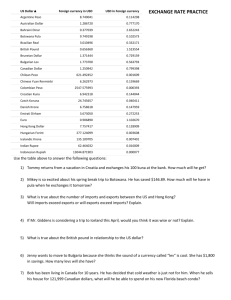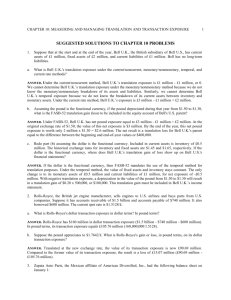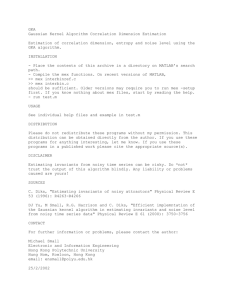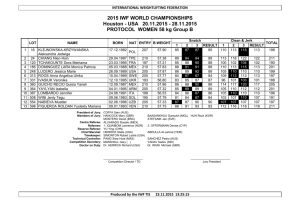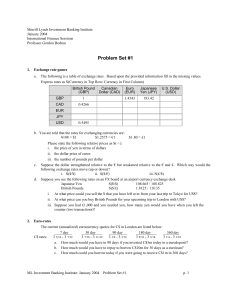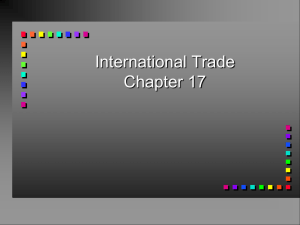PROBLEMS
advertisement
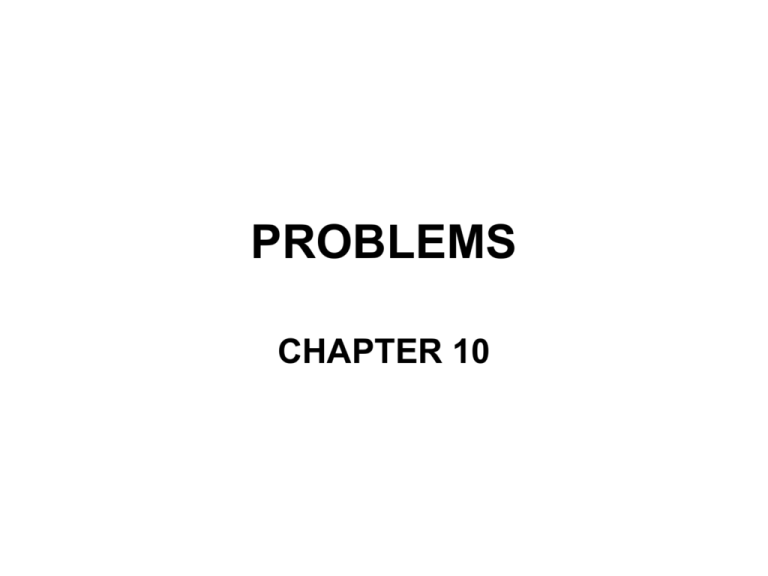
PROBLEMS CHAPTER 10 CHAPTER 10 PROBLEMS • 2. Rolls-Royce, the British jet engine manufacturer, sells engines to U.S. airlines and buys parts from U.S. companies. Suppose it has accounts receivable of $1.5 billion and accounts payable of $740 million. It also borrowed $600 million. The current spot rate is $1.5128/£. • a. What is Rolls-Royce's dollar transaction exposure in dollar terms? In pound terms? • Answer. Rolls-Royce has $160 million in dollar transaction exposure ($1.5 billion $740 million - $600 million). In pound terms, its transaction exposure equals £105.76 million (160,000,000/1.5128). • b. Suppose the pound appreciates to $1.7642/£. What is Rolls-Royce's gain or loss, in pound terms, on its dollar transaction exposure? • Answer. Translated at the new exchange rate, the value of its transaction exposure is now £90.69 million. Compared to the former value of its transaction exposure, the result is a loss of £15.07 million (£90.69 million - £105.76 million). • 3. Zapata Auto Parts, the Mexican affiliate of American Diversified, Inc., had the following balance sheet on January 1: • The exchange rate on January 1 was Mex$ 8,000 = $1. Assets (Mex$ millions) Cash, marketable securities Accounts receivable Inventory Fixed assets Liabilities (Mex$ millions) Mex$ 1,000 50,000 32,000 111,000 Mex$ 194,000 Current liabilities Long-term debt Equity Mex$ 47,000 12,000 135,000 Mex$ 194,000 • a. What is Zapata's FASB-52 peso translation exposure on January 1? • Answer. If the peso is the functional currency, then translation exposure equals Zapata's net worth of Mex$ 135,000 (assuming as before that all assets and liabilities are denominated in pesos), or $16.875 million. • b. Suppose the exchange rate on December 31 is Mex$ 12,000. What will be Zapata's translation loss for the year? • • Answer. The peso has lost one-third of its dollar value during the year. Hence, Zapata's translation loss equals one-third of its initial exposure.If the peso is the functional currency, Zapata's translation loss equals $16,875,000/3 = $5.625 million. • c. Zapata can borrow an additional Mex$ 15,000. What will this do to its translation exposure if it uses the funds to pay a dividend to its parent? If it uses the funds to increase its cash position? • Answer. If Zapata borrows an additional Mex$ 15,000 (in millions) and uses these funds to pay a dividend to its parent, its liabilities will rise by Mex$ 15,000 and its equity will fall by the same amount. With the added peso liabilities, its exposure will fall by Mex$ 15,000 or $1.875 million regardless of the functional currency. • If the peso is the functional currency, the new translation exposure becomes $15 million. If Zapata uses the Mex$ 15,000 to increase its cash position, then its translation exposure stays the same; the added peso liabilities are exactly offset by the added peso assets. • 4. Walt Disney expects to receive a Mex$16 million theatrical fee from Mexico in 90 days. The current spot rate is $0.1321/Mex$ and the 90-day forward rate is $0.1242/Mex$. • a. What is Disney's peso transaction exposure associated with this fee? • Answer. Disney's peso transaction exposure on this fee equals Mex$16 million or $2,113,600 (16,000,00 x 0.1321). • b. If the spot rate expected in 90 days is $0.1305, what is the expected U.S. dollar value of the fee? • Answer. The expected value of this fee in 90 days is $2,088,000 (16,000,00 x 0.1305). • c. What is the hedged dollar value of the fee? • Answer. The hedged value of this fee in 90 days is $1,987,200 (16,000,00 x 0.1242). • 5. A foreign exchange trader assesses the euro exchange rate three months hence as follows: • $1.11 with probability 0.25 • $1.13 with probability 0.50 • $1.15 with probability 0.25 • The 90-day forward rate is $1.12. • a. Will the trader buy or sell euros forward against the dollar if she is concerned • Answer. The expected future spot exchange rate is $1.13 ($1.11 x 0.25 + $1.13 x 0.50 + $1.15 x0.25). Because this exceeds the forward rate of $1.12, the trader will buy euros forward against the dollar. She should buy an infinite amount of euros. This absurd result is due to the assumption of a linear utility function. • b. In reality, what is likely to limit the trader's speculative activities? • Answer. Regardless of her utility function, she will be restrained by bank policies designed to guard against excessive currency speculation. • c. Suppose the trader revises her probability assessment as follows: • $1.09 with probability 0.33 • $1.13 with probability 0.33 • $1.17 with probability 0.33 • Assuming the forward rate remains at $0.92, do you think this new assessment will affect the trader's decision? • Answer. The expected future spot rate remains at $1.13. However, the variance of the expected spot rate is now greater than it was before. If the trader is concerned solely with expected values, this will not affect her speculative activities. But if she is concerned with risk in addition to expected return, the greater variance and consequent greater risk should lead her to reduce her speculative activities. • 7. Magnetronics, Inc., a U.S. company, owes its Taiwanese supplier NT$205 million in three months. The company wishes to hedge its NT$ payable. The current spot rate is NT$1 = U.S.$0.03987, and the three-month forward rate is NT$1 = U.S.$0.04051. Magnetronics can also borrow/lend U.S. dollars at an annualized interest rate of 12 percent and Taiwanese dollars at an annualized interest rate of 8 • a. What is the U.S. dollar accounting entry for this payable? • Answer. Magnetronics will record a payable of U.S.$8,173,350, which is just NT$205 converted at the spot rate of U.S.$0.03987. • b. What is the minimum U.S. dollar cost that Magnetronics can lock in for this payable? Describe the procedure it would use to get this price. • Answer. Magnetronics can use either a forward market hedge or a money market hedge. The forward market hedge will lock in a cost of U.S.$8,304,550 (205,000,000 x 0.04051). Alternatively, Magnetronics can borrow U.S. dollars, convert them into NT$, and invest the NT$ for three months and use the proceeds to settle the NT$ payable. To estimate the cost of this money market hedge, we must work backwards to figure out first how many NT$ are needed today. At a quarterly interest rate of 2%, Magnetronics must invest NT$200,980,392 (205,000,000/1.02) today in order to have NT$205 million in three months. • At the current spot rate, this amount translates into U.S.$8,013,088 today. At a quarterly U.S. interest rate of 3%, this loan will cost U.S.$8,253,481 to repay in three months (8,013,088 x 1.03). Since this amount is $51,069 less than the cost of satisfying the payable using the forward market, it makes sense to use the money market hedge and lock in a cost of U.S.$8,253,481. • c. At what forward rate would interest rate parity hold given the interest rates? • Answer. Interest rate parity will hold when the U.S. dollar return on U.S. dollars, 1.12, equals the hedged U.S. dollar return on NT$, or (1/0.03987) x 1.08 x f, where f is the equilibrium forward rate. The solution to this equation is f = .03987 x 1.12/1.08 = $0.04135. At this forward rate, interest rate parity will hold. • 9. American Airlines is trying to decide how to go about hedging _70 million in ticket sales receivable in 180 days. Suppose it faces the following exchange and interest rates. • Spot rate: $0.6433-42/_ • Forward rate (180 days): $0.6578-99/_ • DM 180-day interest rate (annualized): 4.01%-3.97% • U.S. dollar 180-day interest rate (annualized): • a. What is the hedged value of American's ticket sales using a forward market hedge? • Answer. By selling the ticket receipts forward, American Airlines can lock in a dollar value of 70,000,000 x 0.6578 = $46,046,000. • b. What is the hedged value of American's ticket sales using a money market hedge? Assume the first interest rate is the rate at which money can be borrowed and the second one the rate at which it can be lent. • Answer. American can also hedge it euro receivable by borrowing the present value of _70 million at a 180-day interest rate of 2.005% (4.01%/2), sell the proceeds in the spot market at a rate of $0.6433/_, and invest the dollar proceeds at a 180-day interest rate of 3.99% (7.98%/2). Using this money market hedge, American can lock in a value for its _70 million receivable of $45,907,296 (70,000,000/1.02005 x 0.6433 x 1.0399). • c. Which hedge is less expensive? • Answer. The forward market hedge yields a higher dollar value for the ticket receivables, so it is preferable. • d. Is there an arbitrage opportunity here? • Answer. Yes. By borrowing dollars at a semiannual rate of 4.005% (8.01%/2), converting them to euros at the ask rate of $0.6442, and simultaneously investing the euros at a semiannual rate of 1.985% (3.97%/2) and selling the loan proceeds forward at a bid rate of $0.6578, you can lock in an arbitrage spread of 0.133% semiannually. • e. Suppose the expected spot rate in 180 days is $0.67/SFr with a most likely range of $0.64-$0.70/SFr. Should American hedge? What factors should enter into its decision? • Answer. Based on the expected 180-day spot rate and its expected range, it would appear that American would be better off waiting to convert its ticket sales at the future spot rate. However, American must ask itself where its comparative advantage lies? Does it lie in running an innovative airline or does it reside in trying to outguess apparently sophisticated financial markets? If the former, which most would agree with, American should stick to its knitting and leave the speculation to financial institutions specifically organized for that purpose. • 10. Madison Inc. imports olive oil from Chilean firms and the invoices are always denominated in pesos (Ch$). It currently has a payable in the amount of Ch$ 250 million that it would like to hedge. Unfortunately, there are no pesos futures contracts available and Madison is having difficulty arranging a pesos forward contract. Its treasurer, who recently received her MBA, suggests using Brazilian real to cross-hedge the pesos exposure. • She recently ran the following regression of the change in the exchange rate for the peso against the change in the real exchange rate: • ΔCh$/US$ = 1.6(ΔR/$) • a. There is an active market in forward real. To cross-hedge Madison's peso exposure, should the treasurer buy or sell real forward? • Answer. Given that Madison is short peso and there is a positive correlation between the real and the peso, Madison should create a long position in real; that is, Madison should buy real forward. b. What is the risk-minimizing amount of reais that the treasurer would have to buy or sell forward to hedge Madison's drachma exposure? • Answer. According to the regression, a 1¢ change in the value of the real leads to a 1.6¢ change in the value of the pesos. To cross-hedge the forthcoming payment of Dr, Lit 1.6 must be bought forward for every unit of Dr owed. With a peso exposure of Ch$ 250 million, the exporter must buy forward real in the amount of real 400 million (1.6 x 250,000,000).
